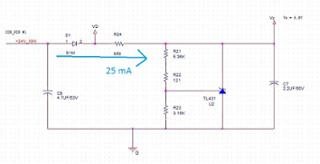Other Parts Discussed in Thread: TL431
The used device is getting heat-up. Please the used ckt as attached.
Input voltage Typ = 24V +/- 4V
Output voltage Vz= 6.8V
Current flowing through TL431 is approx 25 mA.
Please look into the used ckt and guide us, why the device is getting heat-up.
Regards
VB Singh


